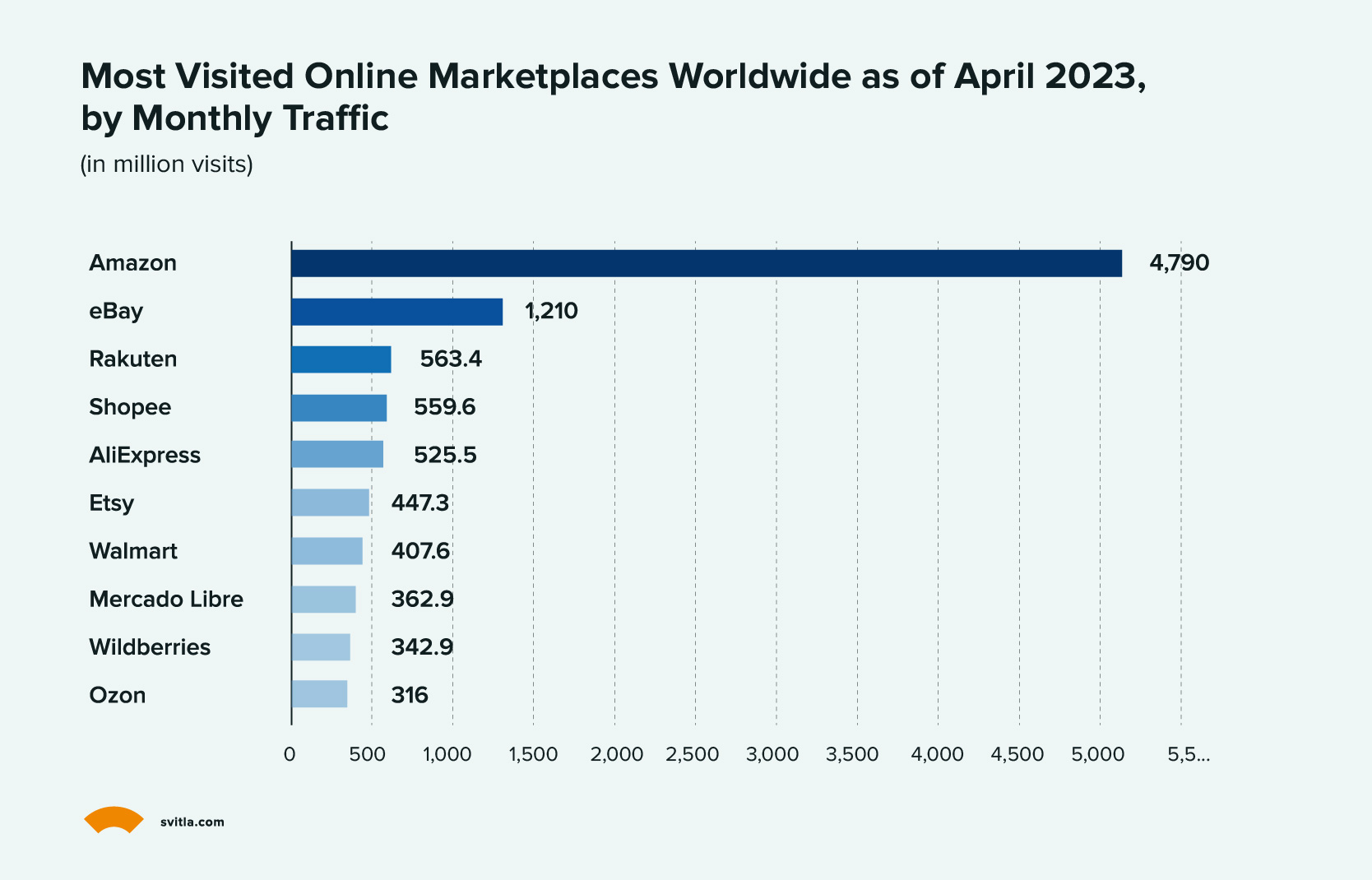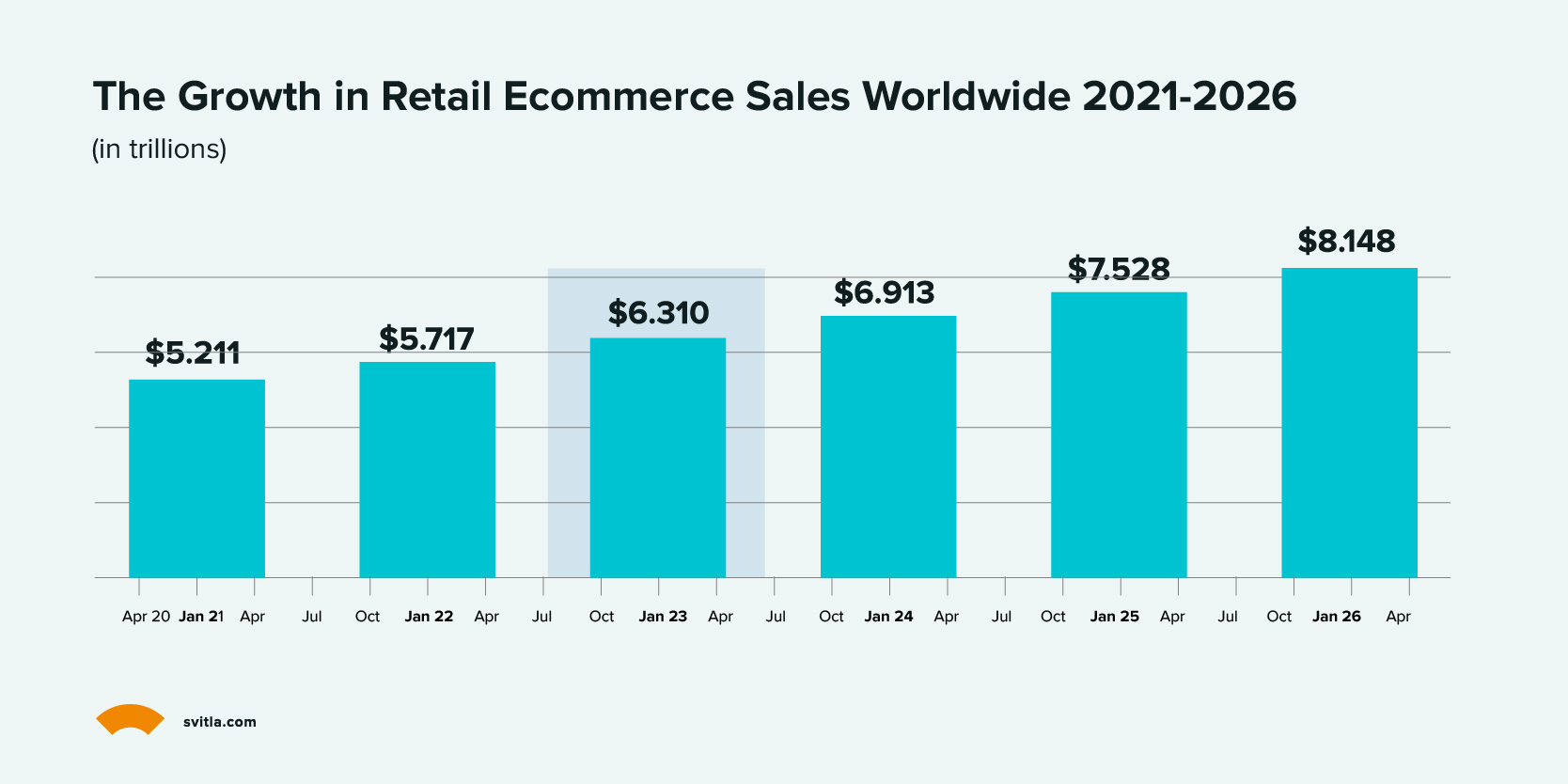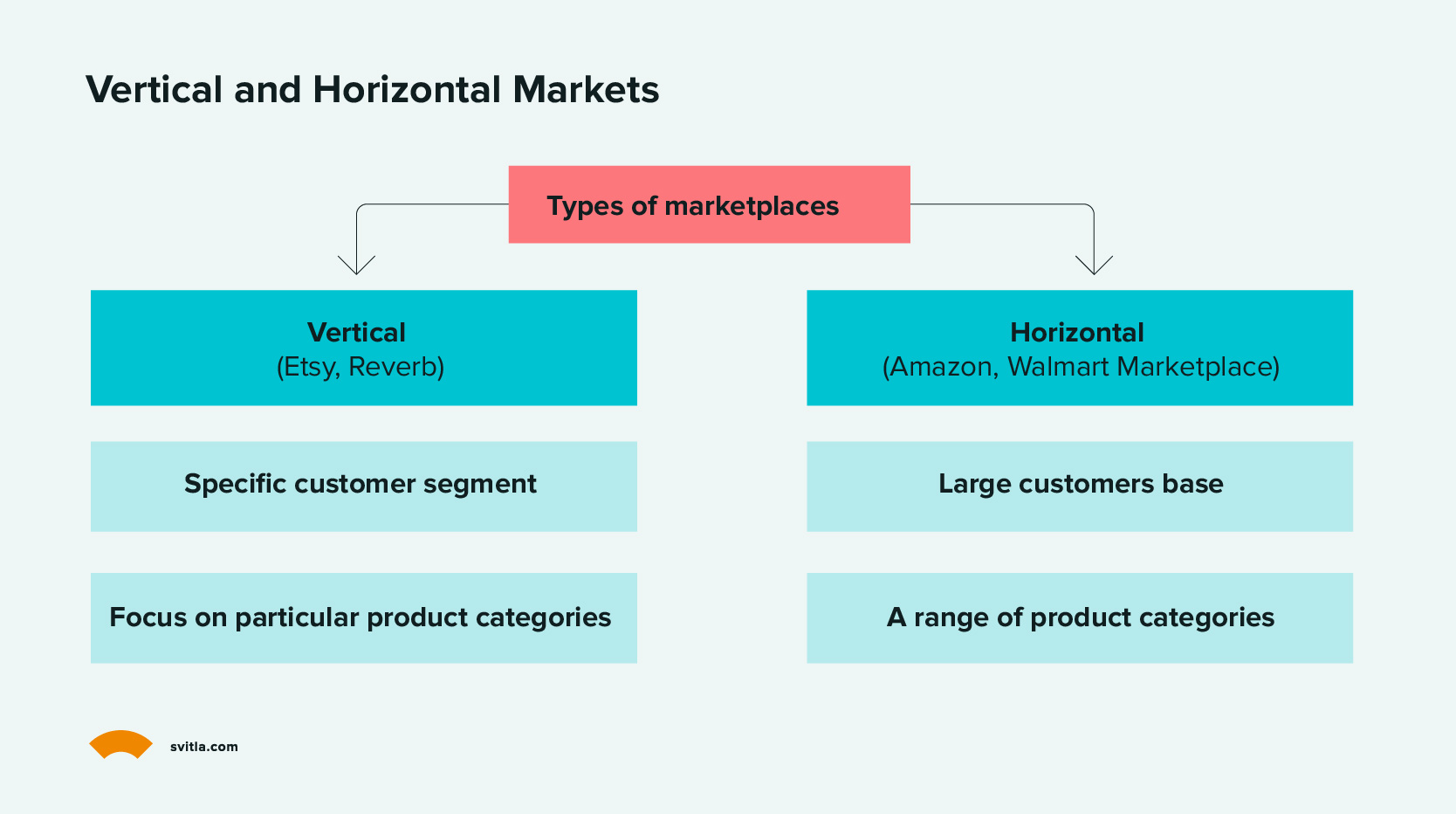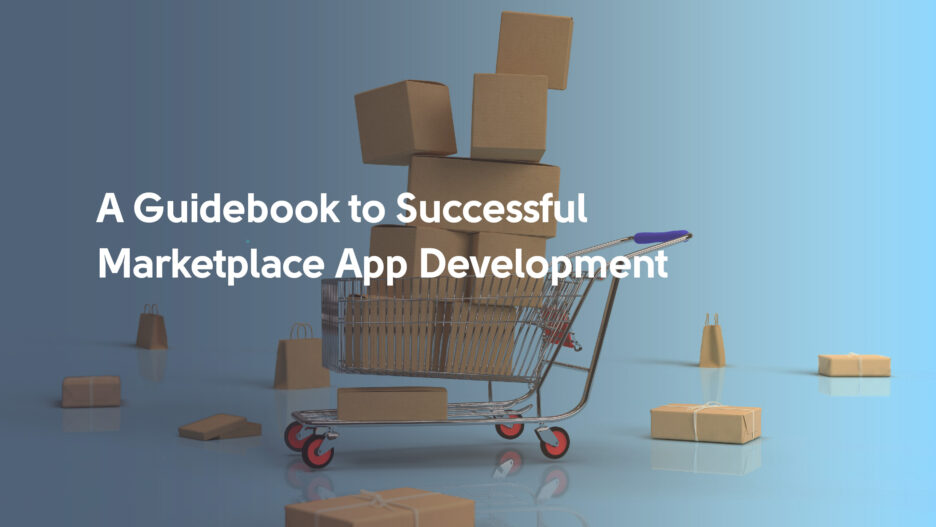Do you have plans to launch a marketplace? Then you're in the right place. This article explores the e-commerce platforms and their types based on their target audience, focus, and management approach. We will also dive deep into the features that make or break a successful online marketplace. Choosing the right business model is key, and we've got you covered on that front, too. And, of course, what's a guide without practical tips on validating your idea? Discover the crucial steps to ensure your concept addresses a genuine need, from testing originality to setting clear business goals.
So, if you're ready to turn your marketplace app development idea into a thriving digital reality, let's start this journey.
What Exactly Is an Online Marketplace?
When you think of a marketplace, you probably picture something like Amazon or eBay – websites where buyers and sellers come together to trade goods. That's a fair example, but online marketplaces come in many shapes and sizes.

In simple terms, a digital marketplace is an e-commerce platform that connects multiple sellers with buyers. Rather than storing inventory like a traditional retailer, the marketplace allows third-party vendors to advertise their products. Shoppers can browse and purchase items from many sources in one place. This typically leads to greater selection and availability than a single brand's online shop.
So why marketplace app development services become so popular in recent years? Well, they offer clear advantages for both buyers and sellers. For vendors, it gives instant access to potential customers. Buyers get the convenience of more choices and easier price comparisons when multiple sellers compete on a single platform.
The marketplace boom took off around 2014 as platforms proliferated across verticals. Today, you can find specialized sites to buy everything from handmade crafts to vacation rentals. Their popularity grows as e-commerce expands globally.

Types of Marketplaces
Online marketplaces come in many shapes and sizes to satisfy different users and needs. Selecting a suitable model is the foundation for vital strategic decisions.
The Types of Marketplaces by Target Audience
Marketplaces can be sorted into three main types based on whom they serve: Business-to-Business (B2B), Business-to-Customer (B2C), and Peer-to-Peer (P2P), occasionally known as Customer-to-Customer (C2C). Let's look closely at each to understand how they work, make money, and what common issues they face.
Business-to-consumer (B2C) marketplaces
The most common marketplace type, B2C platforms, connects third-party businesses selling products or services with end-consumer buyers. They open new sales channels for merchants while offering consumers selection and convenience.
Leading examples span industries like e-commerce (Amazon, eBay), travel (Expedia, Booking.com), food delivery (DoorDash, GrubHub), and home sharing (Airbnb). Strong network effects drive growth as more merchants attract more users.
Business-to-business (B2B) marketplaces
B2B marketplaces simplify wholesale business transactions. They streamline procurement and help companies source everything from raw materials to finished goods more efficiently through a digital platform.
Major B2B examples include Alibaba.com, Amazon Business, and Thomasnet for connecting industrial manufacturers and distributors. Niche players like Faire focus exclusively on wholesale consumer packaged goods.
Peer-to-Peer (P2P) platforms
P2P platforms directly connect individual consumers by exchanging goods, services, and assets. People can transact without a traditional business intermediary. Examples include Etsy, Uber, Lyft, and TaskRabbit (freelance services).
P2P marketplaces unlock access to unique inventory individuals create and facilitate an asset-light “sharing economy.” Growth often hinges on building critical mass in specific metro areas before expanding geographically.
Marketplaces by Focus
Online marketplaces target specialized industry verticals or mass horizontal markets spanning multiple categories. Let’s see how they are different.

Vertical marketplaces
Unlike horizontal players, vertical or “niche” platforms focus on specific product categories, industries, or user segments. For example, StockX (sneakers), Reverb (musical instruments), GoExpedi (automotive supplies), or Farmers Business Network (agriculture).
The narrow target market allows tailored features and specialized industry or user knowledge. The competition also gets segmented rather than head-to-head battles across industries on Amazon or eBay. User and merchant acquisition costs can be lower within a clear niche.
Horizontal marketplaces
Horizontal platforms take the opposite extreme – aggregating a range of product categories, all in one place, to be a broad “one-stop shop” for users across industries. Amazon and Walmart Marketplace lead this approach as digital equivalents of massive physical store networks.
Benefits include enormous product selection and convenience for users, plus platform traffic to attract sellers. Challenges can include more competition for merchants and diluted platform identity across unrelated verticals. Most horizontal players eventually seek to expand vertically once core operations solidify.
Complementary or hybrid marketplaces
Rather than completely horizontal or niche vertical, complementary marketplaces combine products and services from a select set of related industries to meet broader customer needs.
For example, grocery stores are expanding into consumer packaged goods, office supplies, books, and games to complement apparel sales. This helps round out the selection while focusing on comprehensible categories based on customer behavior.
Marketplace by Management Approach
Online marketplaces use different management approaches to simplify transactions. Unmanaged platforms take a hands-off stance. In turn, lightly managed models balance autonomy with basic quality screening, and fully managed marketplaces directly control most aspects of transactions. Let's explore them in more detail.
Unmanaged marketplaces
Unmanaged platforms like eBay, Etsy, and Craigslist take a hands-off approach. They allow buyers and sellers to connect directly based on user-generated ratings, reviews, and trust over time rather than formal vetting.
This simplifies onboarding and organic growth, especially in niche categories. But it also leads to higher risks around scam listings, quality control issues, and lack of customer support for disputed transactions. Fees are generally low to offset the nature of self-service.
Lightly managed marketplaces
Platforms like Uber, Airbnb, and GrubHub invest more moderately in trust and safety mechanisms while maintaining a peer-to-peer exchange. Common tactics include ID verification checks, basic quality screening for service providers, and mediating the rating/review process.
The middle-ground approach targets the “sweet spot,” balancing marketplace control with user autonomy. However, occasional issues can still erode customer experience, requiring reactive and localized responses. Transaction fees fund more support resources.
Fully managed marketplaces
Fully managed models like Opendoor deeply intermediate transactions. They directly handle large parts of vetting, fulfillment, and support. So sellers simply confirm orders rather than directly engaging buyers.
High-touch operations build trust and boost service levels but require significant upfront investments and ongoing overhead to scale. Sellers may feel disconnected from buyers as well. Consequently, fees tend to be higher, with the operators capturing larger value slices per transaction.
Critical Marketplace Platform Features and Capabilities
A successful online marketplace requires more than connecting buyers and sellers. You need to craft tailored experiences to serve both sides of your platform. Here are some of the main features you need to implement.
Customer Features
- Account creation. Allow users to quickly sign up for an account through email and social login options with Facebook, Google, and other digital platforms. Reduce friction by gradually collecting information during account creation and future purchases. Only ask for essential details like name, email, and password to avoid abandonment.
- Search and discovery. Add sorting filters (by price, ratings, number of purchases), intuitive navigation, autocomplete suggestions, and personalized recommendations in search. This helps customers easily find relevant products/services.
- Listings. Comprehensive listings build trust by providing all pertinent details customers require in making informed decisions. Ensure titles and descriptions accurately convey what's being offered. High-quality images from multiple angles give customers clarity.
- Reviews. Authenticate reviews posted by real platform customers. Have moderation tools to prevent review abuse. Display aggregate ratings and individual reviews prominently across the site to ensure credibility and assist purchase decisions.
- Cart and checkout. According to Forbes research, 24% of online shoppers abandon their cart because the site wants them to create an account. Allow customers to make purchases without account creation. Provide multiple payment options like credit card or PayPal for user convenience. Streamline checkout flows with clear calls to action to prevent cart abandonment.
Vendor Features
- Registration. Make seller onboarding smooth by progressively collecting information across multiple steps. Reduce initial friction, but have tools for identity verification before allowing sales.
- Dashboard. Provide a centralized dashboard for vendors like sellers/service providers to access critical business metrics. Show sales reports, order tracking, inventory status, and merchandising performance. It helps them manage operations.
- Inventory management. For product sellers, provide real-time inventory tracking with alerts for stock-outs and fast-selling items. Integrate with sales channels so inventory is deducted automatically with each order.
- Communication. In-platform messaging capabilities for vendors to interact directly with customers. Vendors can provide purchase support, guidance, and enhanced service through such tools.
- Analytics. Share actionable and easy-to-interpret insights on customer behavior and product/service performance trends to aid vendors' decisions. You should also integrate seamlessly with the rest of the platform.
Admin Features
- Multilingual support. Support launching in multiple languages to expand. So, you can go to the new markets.
- Marketing. Provide intuitive, pre-built templates and seamless integration options with email, social media, and paid advertising channels. It helps in managing marketplace promotion across channels.
- CMS. Enable administrators to easily create, edit, or remove marketplace content without developer help. It maintains consistency of brand messaging and voice across customer-facing touchpoints.
- Reporting. Offer intuitive, visual reports tracking KPIs like sales velocity, traffic sources quality, and peak site times to support data-driven decisions on marketplace growth.
How to Monetize a Marketplace
Choosing the right business model is crucial when building an online marketplace. You need to figure out how to extract value from the transactions and interactions happening on your platform. There are several potential approaches, each with pros and cons:
Commissions
Charging a commission or percentage fee from each transaction is the most popular monetization strategy used by leading marketplaces like Airbnb, Etsy, and Uber. This model works well when:
- You can facilitate payments between buyers and sellers
- Typical transaction values are high enough to justify the fee
- Your platform adds value to both sides
Commissions align incentives – you only make money when your users complete transactions. Start with a competitive commission rate to attract users, then optimize based on supply and demand dynamics.
Membership/Subscription Fees
Instead of commissions, charge providers a recurring access fee to be part of the marketplace. This can work well when transaction facilitation is difficult, but your platform offers unique access to potential customers.
For example, LinkedIn charges recruiters to access its exclusive talent pool, while dating sites like eHarmony charge members for vetted introductions. The key is crafting a strong value proposition to compel providers to pay.
Listing Fees
Listing fees allow you to monetize providers based on the volume of inventory they list on your site, rather than completed transactions. For example, Craigslist charges listing fees for job and real estate ads in some high-demand markets.
This model works best for classified sites or other marketplaces where providers want maximum visibility, and only a subset of listings will convert. Listing fees provide platform revenue, even for unused inventory.
Lead Fees
Rather than listings, charge fees when you successfully connect providers with high-intent, qualified leads. For example, Thumbtack charges professionals for customer leads matching their services.
Lead fees work well for service marketplaces where lifetime customer value is high enough to justify fees on a per-lead basis. Focus on lead quality over quantity to drive provider ROI.
Freemium
Offer your core marketplace free of charge, then monetize highly engaged power users via paid premium features. For example, Etsy sellers can pay for promoted listings and direct checkout.
This helps overcome the “chicken and egg” marketplace launch problem by removing initial participation barriers while generating revenue from top users.
Featured Listings & Ads
If facilitating transactions is difficult in your vertical, monetize through advertising instead. For example, Zillow partially monetizes via featured listings for real estate agents.
This model harnesses your audience reach but provides less direct value to marketplace users. It also requires significant traffic volume to drive material revenue.
There is no one-size-fits-all marketplace business model. Most use a combination of the models above to diversify revenue streams. Carefully analyze your industry mechanics, user needs, and platform capabilities to determine the optimal monetization mix.
How to Validate Your Marketplace Idea
You have a fantastic marketplace idea, and you're confident it fills a gap in the market. However, before investing time and resources, ask yourself: Have you gathered enough evidence that your idea addresses a significant problem? Building a successful business requires considerable time and effort, so it's crucial to validate the genuine need for your marketplace before diving into development. Alex Brola, co-founder of CheckMaid.com, an online on-demand cleaning service, shares their experience on validation:
"We validated [the idea] without any cleaners to do the cleanings. We threw up a site, a booking form, a phone number, ran some ads through Google and Bing, and saw the conversion rate if we had cleaners."
Let’s see what the key steps to validate your idea are!
Step #1. Test Marketplace Idea Originality
Research to assess your model or specific features to know if they already exist in the market. Competitor offerings may seem different, but solve the exact core user needs. If your idea is unoriginal, all hope is not lost. Consider how you could improve upon existing solutions, adapt components, or combine elements in new ways that provide greater value to users.
Step #2. Conduct Competitor Analysis
Identify direct competitors and substitute offerings fulfilling similar target user needs. Map the competitive landscape, analyzing where alternatives fall on pricing, quality, convenience, and more attributes. Objectively judge competing solutions' strengths and weaknesses by actually testing them. Seek to pinpoint gaps in the market. Also, research of similar marketplace failures – often execution missteps, provides invaluable insights.
Step #3. Get Target Audience Feedback
Seek feedback directly from diverse potential user groups representing your target personas. You require at least 30–50 interviews to reach data saturation. Consider incentives to encourage participation and mitigate self-selection biases. Start broad, then hone in on fundamental needs and pain points. React based on insights, not attachments or assumptions. Rob Infantino, the CEO of OpenBay, an automotive repair and maintenance service platform, shared:
"When I came up with the concept for this online marketplace, I didn't stay confined to my office. I went out and engaged with potential users to validate the idea. Because I was developing a platform connecting both vehicle owners and automotive service providers, I had meaningful conversations with both groups. They provided valuable insights into their challenges, requirements, and expectations, shaping the direction of the platform."
Step #4. Set Clear Business Goals
Follow the SMART goal framework to ground your goals. The critical thing to remember is that your goals must be specific, measurable, achievable, relevant, and time-bound. A good example of the SMART-driven goal may be like: “Attract 500 new active buyers and sellers over the next 9 months.” Quantifiable aims allow you to track progress.
Additionally, concentrate efforts on just 2–3 primary goals at once. Trying to tackle too many objectives at the same time scatters focus. Pursuing a targeted set of goals enables you to create an effective plan and allocate resources accordingly.
Step #5. Build a Minimum Viable Product (MVP)
The last step is the product validation stage. By now, you're sure there's a significant market for your idea, with eager customers willing to pay for it. The platform validation also confirms ample demand for the proposed products, ensuring potential buyers are willing to purchase.
To attract early users for your MVP, engage with potential consumers identified in the previous step and ensure a critical mass of testers and early users before launching your MVP. Gathering sufficient input from them is crucial for verifying your MVP.
To Conclude
Successful online marketplace development takes careful planning and validation. First, research to ensure your idea fills a real market need with an innovative solution. Talk to potential users and analyze competitors to identify gaps you can fill.
Once you confirm demand, create a basic MVP to test assumptions. Gather user feedback to refine the MVP before the full launch. Also, decide how to make money through commissions, fees, subscriptions, etc.
The most important is to stay flexible on your way. Don't get attached to one feature or idea. Let users guide you to build something that brings value. Meet their needs first, and growth will follow.
With proper research and validation upfront, you can create something users love. There's no one formula for marketplace magic, but following core best practices will put the odds in your favor.
Have an idea of a marketplace in mind? Svitla Systems is here to help you. Contact us to consult you and make your dream project a reality.





![[Blog cover] SEO optimization best practices](https://svitla.com/wp-content/uploads/2025/05/Blog-cover-SEO-optimization-best-practices-560x310.jpg)